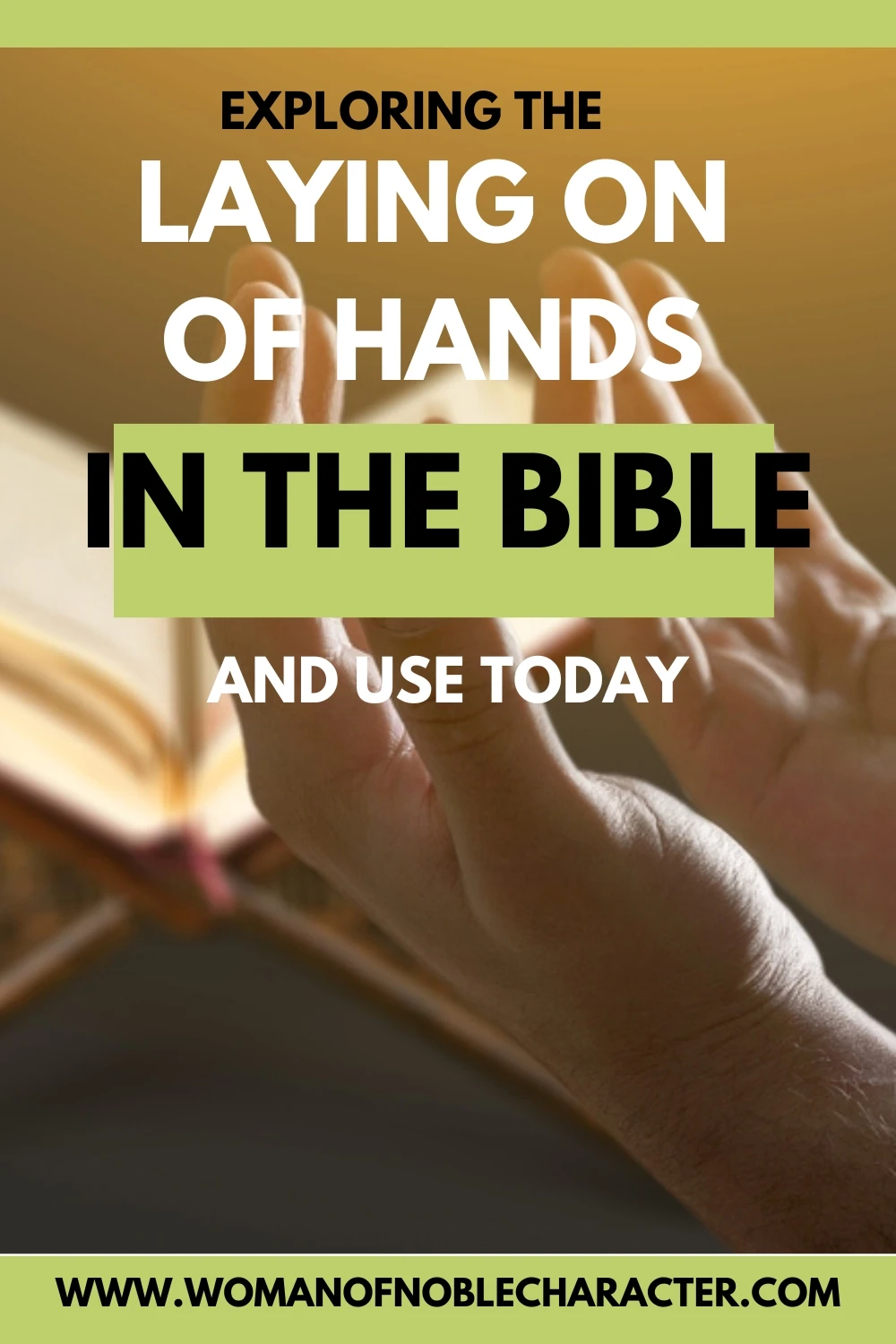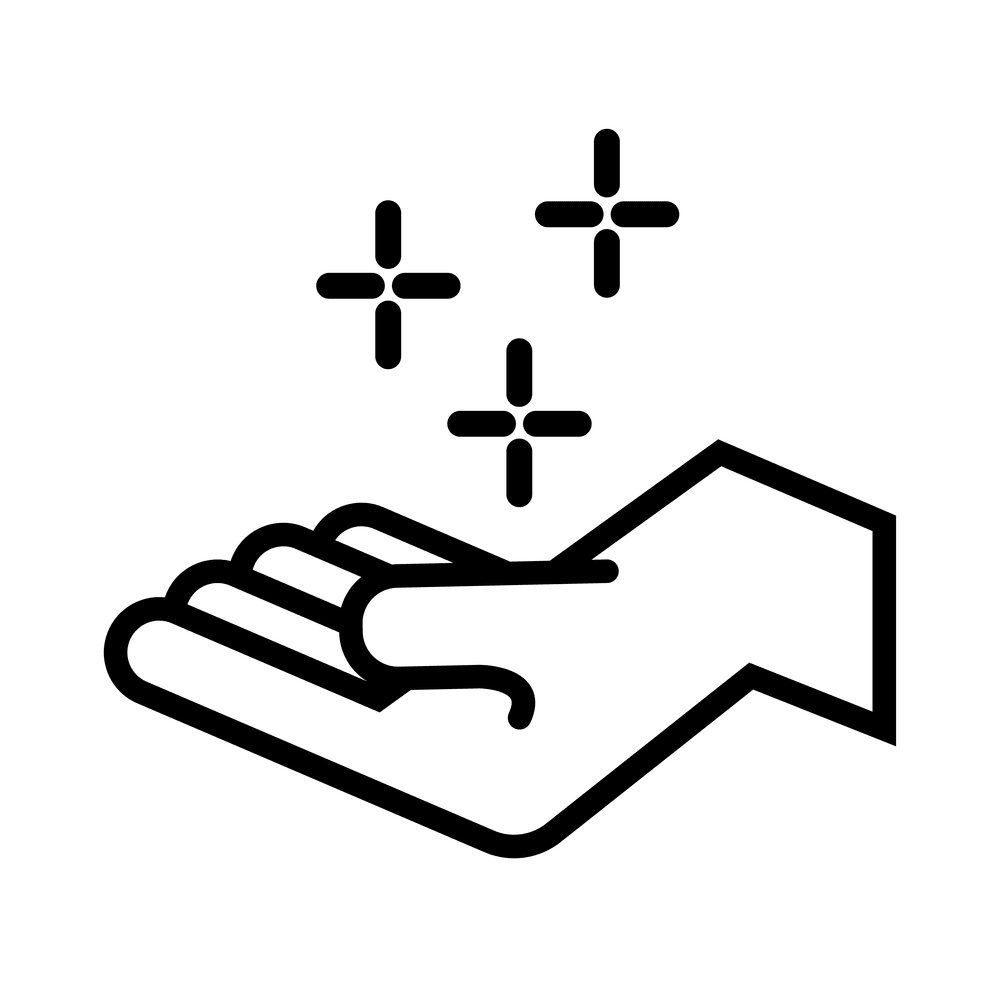This page/post may contain affiliate links. As an Amazon Associate, as well as an affiliate of other programs, this means if you purchase something using these links, I will receive a commission on qualifying purchases at no cost to you! For more detailed information, please visit our Affiliate Disclaimer page
What is the laying on of hands in the Bible?
The laying on of hands is a visible sign and spiritual affirmation that activates the Holy Spirit. It’s a church tradition that’s part of the outward expressions that connect the church and shows the power of the Holy Spirit at work. Along with it is the anointing of the head with oil and baptism.
It’s been used when anointing someone who has spiritual gifts and giving them a formal commission to use their gift for God’s work. This physical action is a way of making healing and passing on a blessing visible, public, and memorable both for the person and the church.
Through the laying of hands, we see the Lord’s grace flow through the members of the body. In the word of God, we find various instances of the use of this visible marker in the lives of Christians.

Laying on of hands in the Old Testament
In the Old Testament, we will explore significant times when people were laid hands on. There were times when it was used in negative senses such as when God told Father Abraham not to lay a hand on Isaac when he was about to sacrifice him in Genesis 22:12.
In Exodus 7:4, God told Moses that he would lay his hands on Egypt if they refused to let the children of Israel go. Nehemiah warned the merchants and sellers not to come inside the gates of Jerusalem during the time of Sabbath, and if they did he would lay his hands on them in Nehemiah 13:21. Haman wanted to lay his hands on Mordecai for not bowing to him in Esther 3:5-6.
In all these instances the laying on of hands meant inflicting harm on the person. However, we will explore the special use of this act.
The form you have selected does not exist.
Giving a spiritual blessing
The laying of hands on a person’s head was a way of giving them a spiritual blessing. An Old Testament example is given in Genesis 48:13-20.
Joseph came with his children so Jacob could bless them. Jacob who was old put his left hand on Manasseh’s head and his right hand on the head of Ephraim but Manasseh was the firstborn and Ephraim the younger brother. The right hand is the hand of strength, and it was supposed to go on the firstborn.
Not only did Jacob intentionally place his hands on the boys in a manner that wasn’t traditional, but which hand was on which head indicated the greatness of the blessing.
So Jacob blessed the boys that day with this blessing: “The people of Israel will use your names when they give a blessing. They will say, ‘May God make you as prosperous as Ephraim and Manasseh.’” In this way, Jacob put Ephraim ahead of Manasseh.
Genesis 48:20 NLT
Laying hands on an animal
In the Book of Leviticus, the duly appointed priests would lay their hands on the head of the bull or live goat to transfer their sins and the sins of others to the animal. The animal was a sin offering and would then be killed so that its blood atones the sins of the people. In the case of the goat, it was released into the wild.
If his offering is a burnt offering from the herd, he shall offer a male without blemish. He shall bring it to the entrance of the tent of meeting, that he may be accepted before the Lord. He shall lay his hand on the head of the burnt offering, and it shall be accepted for him to make atonement for him.
Leviticus 1:3-4 ESV
And when he has made an end of atoning for the Holy Place, the tabernacle of meeting, and the altar, he shall bring the live goat. Aaron shall lay both his hands on the head of the live goat, confess over it all the iniquities of the children of Israel, and all their transgressions, concerning all their sins, putting them on the head of the goat, and shall send it away into the wilderness by the hand of a suitable man. The goat shall bear on itself all their iniquities to an uninhabited land; and he shall release the goat in the wilderness.
Leviticus 16:20-22 NKJV
Ordaining someone for the ministry
In the Old Testament, people were also being laid hands on when they were being ordained into a leadership role and were about to do God’s mighty work. This was a formal commission of the work they were about to start.
While ordination is usually done by the leader of the church, in Numbers 8:9-10, God told the Israelites to dedicate the Levites to the Lord’s service as their priests. They were blessing their work and showing they would support them in their new role.
When Moses was old, God told him to lay hands on Joshua to be his successor. Joshua was full of the spirit of God and ordained in a public ceremony before the priests and the entire congregation.
The laying of hands to a new leader gives them both blessing and authority to act in that position. When Joshua was ordained, he was empowered to lead the people of Israel after Moses.
So the Lord said to Moses, “Take Joshua the son of Nun, a man in whom is the Spirit, and lay your hand on him. Make him stand before Eleazar the priest and all the congregation, and you shall commission him in their sight. You shall invest him with some of your authority, that all the congregation of the people of Israel may obey.
Numbers 27:18-20 ESV
The laying of hands on someone showed that the hand of the Lord was upon the new leader to guide him in his new role.
Laying on of hands in the New Testament
In the New Testament particularly the Gospels and Book of Acts, we see instances of the laying on of hands on people who were sick, children, and on new missionaries. This was a new positive use of the phrase without the negative uses of the Old Testament.
Laying on of hands on a sick person
One of the ways Jesus Christ used to heal people with various diseases was the laying on of hands.
He healed the blind man by laying his hands on him in Mark 8:23-25, cast out demons by laying his hands on them in Luke 4:40-41 and raised the dead by laying his hands in Matthew 9:18-25.
But the power of God to heal is not only reliant on the laying on of hands. There were times like in Matthew 8:6-10 when Jesus healed the servant of the centurion without going near the centurion’s house.
Jesus lays his hands on children
Christ Jesus loves little children, and in the scripture we see him embracing them. He actually said the kingdom of God belongs to the little ones. Among other attributes, little children are pure, trusting, and forgiving and that’s how we ought to be to enter heaven.
We see an example of Jesus laying his hands on children not to heal them but to bless them, connect with them and show them, love.
And He took them up in His arms, laid His hands on them, and blessed them.
Mark 10:16 NKJV
Receiving the Holy Spirit
When the Holy Spirit first came upon the disciples in Acts 2, they were all in one room, and flames or tongues of fire came upon them, and they began to speak in new tongues. They all received the gift of the holy spirit, and this gave them the boldness to start preaching the Gospel.
After preaching, the disciples would do the baptism of repentance. Then to give people a visible marker of them receiving the holy ghost, the disciples would lay hands on the newly baptized person.
Then they laid their hands on them and they received the Holy Spirit.
Acts 8:17 ESV
On hearing this, they were baptized in the name of the Lord Jesus. And when Paul had laid his hands on them, the Holy Spirit came on them, and they began speaking in tongues and prophesying.
Acts 19:5-6 ESV
As Apostle Paul and the other disciples laid hands on the early church to receive the Holy Spirit they would also receive the gifts of the holy spirit. These include speaking in other tongues, interpreting tongues, prophesying, healing, performing miracles, and other gifts.
However, we learn in Acts 10:44-46 that the holy spirit descended on people while Peter was still speaking and he didn’t lay hands on them. The way God works is different, and his ways and thoughts are higher than ours.
The apostles lay hands on sick people
After an encounter with Jesus on the road to Damascus, Saul whose name later changed to Paul became blind. He was healed through the laying on of hands and was empowered by receiving the holy ghost to start preaching the Gospel.
So Ananias went and found Saul. He laid his hands on him and said, “Brother Saul, the Lord Jesus, who appeared to you on the road, has sent me so that you might regain your sight and be filled with the Holy Spirit.”
Acts 9:17 NLT
Ananias laid his hands on Saul and he was filled with the Holy Spirit and was also healed. It’s important to point out that Ananias was sent by God to do this and it wasn’t his own thinking. Paul went on to heal others through the laying on of hands, continuing the healing ministry Jesus had started.
And it happened that the father of Publius lay sick of a fever and dysentery. Paul went in to him and prayed, and he laid his hands on him and healed him. So when this was done, the rest of those on the island who had diseases also came and were healed.
Acts 28:8-9 NKJV
Laying on of hands by the church elders
Timothy who was a disciple of Paul and had the gift of teaching, and the elders of the church laid their hands on him as a formal commission of his ministry.
Do not neglect the gift that is in you, which was given to you by prophecy with the laying on of the hands of the eldership.
1 Timothy 4:14 NKJV

That is why I remind you to fan into flame the gracious gift of God, [that inner fire—the special endowment] which is in you through the laying on of my hands [with those of the elders at your ordination].
2 Timothy 1:6 AMP
It was not enough though to have the gift Paul highlighted to Timothy. He had to put that gift into practice by serving the church so that he could grow in it and glorify God.
We see the apostles laying hands on seven men selected in the church to manage the church’s food program. This was administrative work, but the apostles still asked for men that were full of the spirit of wisdom and well-respected in Acts 6:3-6.
This was a public ceremony, and the men were laid hands on by the church leaders to confirm their positions, bless their work, and support them in their roles.
In another instance, we see Paul and Barnabas being ordained for ministry work.
One day as these men were worshiping the Lord and fasting, the Holy Spirit said, “Appoint Barnabas and Saul for the special work to which I have called them.” So after more fasting and prayer, the men laid their hands on them and sent them on their way.
Acts 13:2-3 NLT
The men were worshipping and fasting when God spoke to them. The spirit of God moves and speaks when we worship, pray, and fast because it shows our commitment to him.
In the New Testament, we also see that the laying on of hands was one of the teachings the church had to go through. The writer of the book of Hebrews encourages the church to go beyond the basics of the Christian faith and become mature and more Christlike. Some of them were supposed to be teachers at this stage but were still having discussions about the elementary principles of Christ.
Therefore let us leave the elementary doctrine of Christ and go on to maturity, not laying again a foundation of repentance from dead works and of faith toward God, and of instruction about washings, the laying on of hands, the resurrection of the dead, and eternal judgment.
Hebrews 6:1–2 ESV
The form you have selected does not exist.
In the church today, Christian ordination still occurs with leaders laying their hands on missionaries, deacons, pastors, elders, and others whom they are commissioning to go forth and serve. But as Paul warned Timothy, this act should not be done without the Lord’s leadership and guidance.
Do not lay hands on anyone hastily, nor share in other people’s sins; keep yourself pure.
1 Timothy 5:22 NKJV
This spiritual act affirms a person in the Spirit, and if that person is not worthy of that affirmation because of their character, the Spirit should not be called upon to move. It’s important to remember that the laying on of hands is an external sign and means of grace.
Today’s church should still observe this tradition because of the spiritual significance it has but do it prayerfully and cautiously. God is not limited to only laying of hands for blessing, healing, receiving of the holy spirit, and ordination.
You may enjoy this video by Rick Renner: The Laying on of Hands
Or one of these recommended resources:
God’s Power Through the Laying on of Hands by Norvel Hayes
The Laying on of Hands: The Elementary Doctrines By Sam Soleyn (Ron Cottle Teaches the Masters) by Dr. Ronald E. Cottle
NLT – Holy Bible: New Living Translation. 1994, 2004, 2007, 2013. Carol Stream, IL: Tyndale House Publishers
ESV – “Scripture quotations are from The ESV® Bible (The Holy Bible, English Standard Version®), copyright © 2001 by Crossway, a publishing ministry of Good News Publishers. Used by permission. All rights reserved.”
NKJV – Scripture taken from the New King James Version®. Copyright © 1982 by Thomas Nelson. Used by permission. All rights reserved.
